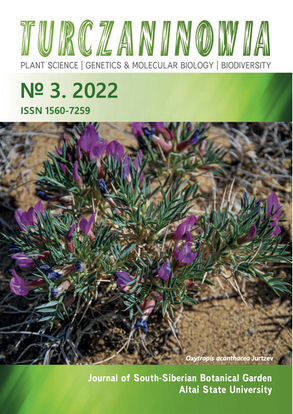Notes on the distribution of Ligularia kingiana (W. W. Sm.) Hand.-Mazz. (Asteraceae): new records
Abstract
The Himalayan species Ligularia kingiana (W. W. Sm.) Hand.-Mazz., which for a long time was considered as endemic to the state of Sikkim (India), was first found during field work in the state of Nagaland, almost 700 km from the type locality. The study of herbarium materials and literature revealed that this rare species also occurs in eastern Nepal (Solukhumbu District) and northern Myanmar (Kachin State). For Nepal, L. kingiana is reported for the first time.
Downloads
Metrics
References
Handel-Mazzetti H. 1938. Plantae novae Tibeticae et Bhutanicae in Herbario Musei Britannici. J. Bot. 76: 281–291.
Illarionova I., Ranjan V., Kumar A. 2012. Lectotypification of Senecio kingianus W. W. Sm. (Asteraceae). J. Jap. Bot. 87(5): 358–360. URL: http://www.jjbotany.com/pdf/JJB_087_358_360.pdf
IUCN [2012]. IUCN Red List Categories and Criteria: Version 3.1. Second edition. Gland, Switzerland and Cambridge, UK: IUCN. iv + 32 pp.
Kandel P., Chettri N., Chaudhary R. P., Badola H. K., Gaira K. S., Wangchuk S., Bidha N., Uprety Y., Sharma E. 2019. Plant diversity of the Kangchenjunga Landscape, Eastern Himalayas. Plant Diversity 41(3): 153–165. DOI: 10.1016/j.pld.2019.04.006
Kress W. J., De Filipps R. A., Farr E., Kyi D. Y. Y. 2003. A checklist of the trees, shrubs, herbs, and climbers of Myanmar (Revised from the original works by J. H. Lace, R. Rodger, H. G. Hundley, and U Chit Ko Ko on the “List of trees, shrubs, herbs and principal climbers, etc. recorded from Burma”). Contr. U. S. Natl. Herb. 45: 1–590.
Liu S. W., Illarionova I. 2011. Ligularia. In: Zh. Y. Wu, P. H. Raven, D. Y. Hong (eds.). Flora of China. Vol. 20–21 (Asteraceae). St. Louis: Science Press, Beijing, and Missouri Botanical Garden Press. Pp. 376–415. URL: http://www.efloras.org/florataxon.aspx?flora_id=2&taxon_id=118542
Mathur R. 1995. Senecioneae. In: P. K. Hajra, R. R. Rao, D. K. Singh, B. P. Uniyal (eds.). Flora of India. Vol. 13. Calcutta: Botanical Survey of India. Pp. 186–323.
Naithani H. B. 1990. Flowering plants of India, Nepal and Bhutan (not recorded in Sir J. D. Hooker's Flora of British India). Dehra Dun. 711 pp.
Rao R. R., Chowdhery H. J., Hajra P. K., Kumar S., Pant P. C., Naithani B. D., Uniyal B. P., Mathur R., Mamgain S. K. 1988. Florae Indicae Enumeratio – Asteraceae. Calcutta: Botanical Survey of India. 119+2 pp.
Singh P., Dash S. S., Sinha B. K. 2019. Plants of Indian Himalayan region (An annotated checklist & pictorial guide). Part 1. Kolkata: Botanical Survey of India. 650 pp.
Smith W. W. 1911. Plantarum novarum in herbario horti regii Calcuttensis cognitarum decas. J. Proc. Asiat. Soc. Bengal. 7: 69–75.
Turczaninowia is a golden publisher, as we allow self-archiving, but most importantly we are fully transparent about your rights.
Authors may present and discuss their findings ahead of publication: at biological or scientific conferences, on preprint servers, in public databases, and in blogs, wikis, tweets, and other informal communication channels.
Turczaninowia allows authors to deposit manuscripts (currently under review or those for intended submission to Turczaninowia) in non-commercial, pre-print servers such as ArXiv.
Authors who publish with this journal agree to the following terms:
- Authors retain copyright and grant the journal right of first publication with the work simultaneously licensed under a Creative Commons Attribution License that allows others to share the work with an acknowledgement of the work's authorship and initial publication in this journal.
- Authors are able to enter into separate, additional contractual arrangements for the non-exclusive distribution of the journal's published version of the work (e.g., post it to an institutional repository or publish it in a book), with an acknowledgement of its initial publication in this journal.
- Authors are permitted and encouraged to post their work online (e.g., in institutional repositories or on their website) prior to and during the submission process, as it can lead to productive exchanges, as well as earlier and greater citation of published work (See The Effect of Open Access).





